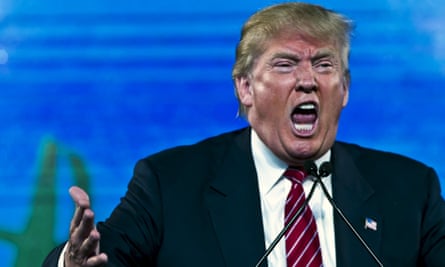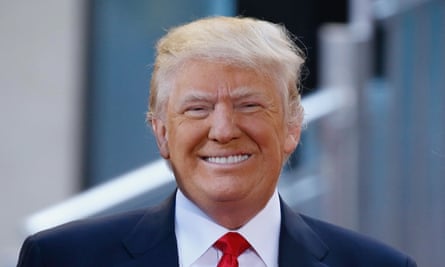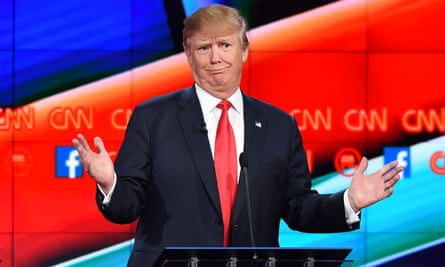A great deal of Donald Trump’s political success can be put down to his body language and the unusual ways he uses his face. The first thing we notice about Trump’s facial expressions is the sheer variety. The second is their dramatic, often over-stated character. This was evident before and during the presidential election. While the other candidates – Hillary Clinton included – were struggling to appear likeable and restrained, Trump was busy performing grimaces that would not have looked out of place in Japanese Noh theatre. But what are Trump’s signature facial expressions, and what do they tell us about him?
1. Alpha face

During the campaign, Trump eclipsed Clinton in the macho stakes. He did this by adopting an “alpha face” of lowered brows, narrowed eyes and a firmly set mouth. This expression is the antithesis of submissiveness. Psychologists have discovered that smiling men are widely perceived as less dominant and that powerful men show reduced levels of smiling. Individuals who want to demonstrate that they are not a threat are more likely to raise their eyebrows, widen their eyes and flash a smile – the precise opposite of what Trump does in this effort to remind everyone that he is not the kind of guy you can push around.
2. Angry face

Most politicians, when they are angry, will allow themselves a modicum of indignation. That’s not enough for Trump. When he’s incensed, he pulls out all the stops and produces a larger-than-life spectacle of fury – eyes narrowed, brows tightly knitted together, mouth open and jaw tense. It is tempting to think that Trump’s outbursts come from a lack of inhibition, but their true source is more likely to be his realisation that exhibitions of anger reinforce an impression of dominance. This is certainly in line with research by psychologists, which shows that people with a strong sense of entitlement, or who see themselves as powerful and unchallenged, are more ready to engage in public displays of anger than others.
3. Chin-jut

One of the ways that Trump tries to look like a tough politician is by jutting out his chin. The chin-jut relies on the fact that men with bigger chins have higher levels of testosterone and, partly for this reason, are more likely to reach positions of power. In a study at West Point military academy in the US, for example, it was discovered that male cadets who had larger chins were more likely to reach the rank of general in later life than their small-chinned peers. By using the chin-jut, Trump is taking full advantage of this fact – tilting his head back, thrusting out his lower jaw and attempting to give the impression that he deserves to be in charge.
4. Big smile

Although Trump instinctively recognises the demeaning potential of smiling, there are occasions when he is prepared to throw caution to the wind and give a full-blown smile, with his teeth on display and wrinkles around the corners of the eyes – the latter being the feature that defines a genuine as opposed to a fake display of happiness. Trump tends to produce these beaming smiles when he is in a convivial setting and when he doesn’t feel the need to look like a leader, or when he is with people whose company he enjoys – as demonstrated by his post-election photograph with Nigel Farage.
5. Zipped smile

This is the smile that Trump defaults to when he is in the public eye: the mouth is closed and the teeth remain hidden. That’s because the risorius muscles, which pull the corners of the mouth sideways, are much more active in this case than the zygomatic major muscles, which pull the corners of the mouth upwards and are otherwise involved in a full-blown smile. The result of this is that the zipped smile appears more guarded – and because the mouth is stretched sideways, it makes the face look slightly wider.
There could be several reasons why Trump is so attached to the zipped smile. One is that it makes him look less submissive. By avoiding a full-blown smile, he is able to appear circumspect, while keeping his options open – something he evidently likes to do.
Another reason is that zipped smiles make the mouth look wider. There is evidence, both from animals and humans, that mouth width is linked to readiness to engage in physical combat, and it has also been found that men with wider mouths are more likely to attain leadership positions. Trump might also be unconsciously attracted to the zipped smile because it increases the apparent width-to-height ratio of his face, which in turn makes him look more masculine and macho. Psychologists have consistently shown that men with a high facial width-to-height ratio are not only seen as tougher and more attractive, they also have higher levels of testosterone and are actually more competitive.But there is always the possibility that the origins of Trump’s zipped smile are cultural rather than personal. It is known, for example, that while Americans favour a full-blown smile that showcases the teeth, British people have historically preferred tight-lipped versions of the smile. There is every chance therefore that Trump’s zipped smile is actually a throwback to his Scottish ancestors – which would of course demonstrate that his public persona is far less American than he has led us to believe.
6. Puckered chin

Some of Trump’s zipped smiles are straightforward, but a large proportion of them are accompanied by a puckeredchin. These are what psychologists call “blended facial expressions”. The presence of this additional facial expression is quite significant because people often pull their chins in when they feel threatened – it’s a way of tensing the chin in anticipation of being symbolically punched in the face. The fact that a puckered chin features in so many of Trump’s zipped smiles suggests that he frequently feels threatened. Because zipped smiles are so effective at capturing people’s attention, they provide a perfect vehicle for Trump to disguise his feelings of vulnerability. All this is likely to be entirely unconscious, but by unwittingly externalising his feelings in this way Trump proves that he is not as tough as he would like everyone to think.
7. Exaggerated mouth

You can’t help notice the way Trump protrudes and contorts his mouth. In fact, his lips appear to have an almost prehensile quality, as if they were an extra pair of hands, reaching out from his face to manipulate the world around him. There are, however, at least two explanations we might consider. One is that Trump amplifies his lip movements because he is not completely convinced that people fully understand what he’s saying. Studies have shown that when mothers are talking to their infants, they often protrude their lips and make exaggerated mouth movements in an attempt to make themselves better understood. Is Trump operating on a similar assumption? Does he feel that the capacity of his audience to understand is so limited that he needs to enlist every articulatory channel to get his message across?
It is also conceivable that Trump’s exaggerated mouth movements are simply another example of a generalised strategy that involves using “supernormal stimuli” to attract attention to himself. The term supernormal stimuli” was coined by the eminent zoologist, Nico Tinbergen, who discovered that herring gulls and stickleback fish responded with greater vigour when they were presented with exaggerated stimuli than when they were exposed to the stimuli they would normally encounter. Recent research on humans suggests that, like birds and fish, we too have an innate orienting reflex to supernormal stimuli, and that we respond more powerfully to things that are larger-than-life, whether in the realm of luxury goods, food or sex. Maybe Trump’s mouth movements – together with his histrionic hand gestures and overstated opinions – are all unknowingly designed to capitalise on this human reaction.
